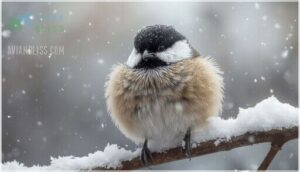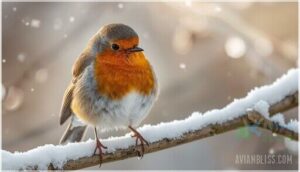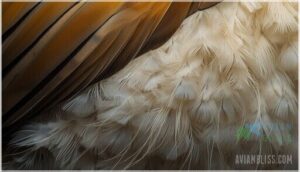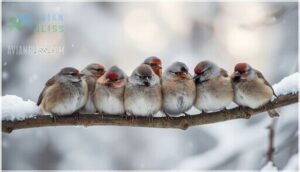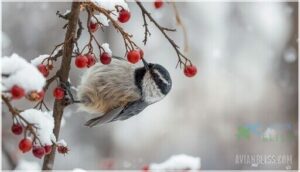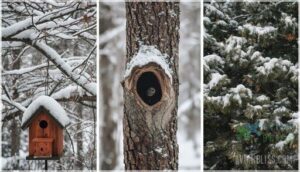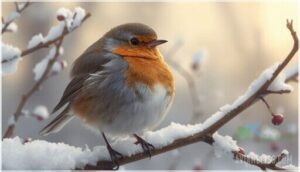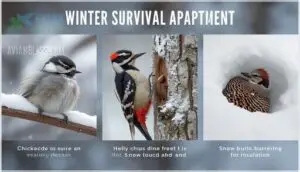This site is supported by our readers. We may earn a commission, at no cost to you, if you purchase through links.
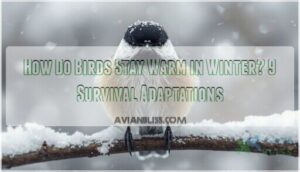 A chickadee weighing less than half an ounce can survive nights when temperatures plunge to -40°F, burning through nearly 10% of its body weight in stored energy before dawn. This feat seems impossible for such a tiny creature, yet millions of birds across hundreds of species endure winter’s harshest conditions without the luxury of heated homes or insulated coats.
A chickadee weighing less than half an ounce can survive nights when temperatures plunge to -40°F, burning through nearly 10% of its body weight in stored energy before dawn. This feat seems impossible for such a tiny creature, yet millions of birds across hundreds of species endure winter’s harshest conditions without the luxury of heated homes or insulated coats.
Their survival depends on an impressive suite of physiological and behavioral adaptations that work together like a finely tuned heating system. From specialized feather structures that trap warmth more effectively than synthetic insulation to metabolic adjustments that balance energy conservation with heat production, birds employ strategies that allow them to thrive when other animals retreat or hibernate.
Understanding these adaptations reveals not only how birds stay warm in winter but also how you can support these resilient creatures through the coldest months.
Table Of Contents
- Key Takeaways
- Bird Body Temperature Regulation
- Insulating Feathers and Plumage
- Behavioral Adaptations for Winter
- Finding Food in Winter
- Bird Migration and Wintering Grounds
- Shelters and Roosting Sites
- Human Assistance for Winter Birds
- Fat Storage and Energy Reserves
- Specific Bird Adaptations and Behaviors
- Frequently Asked Questions (FAQs)
- How do birds not freeze in the winter?
- What temperature is too cold for birds?
- Where do birds go in extreme cold?
- What do birds do when it snows?
- How do birds circulatory systems adapt to the cold?
- What role do hormones play in birds winter survival?
- How do birds sensory systems detect food in snow?
- What genetic traits aid birds in surviving winter?
- How does winter affect birds reproductive strategies?
- Do birds sleep differently in extreme cold?
- Conclusion
Key Takeaways
- Birds maintain body temperatures between 105°F and 110°F through metabolic rates 30–40% faster than mammals, with winter metabolic rates spiking 23% higher than spring to fuel constant heat generation and overnight survival that burns nearly 10% of body weight daily in small species.
- Specialized feather structures create multiple insulating layers that trap air pockets reducing heat loss by 30–50%, while behavioral adaptations like fluffing feathers can increase insulation by 60% and ptiloerection activates within seconds to maintain skin temperatures 10°C warmer than ambient air.
- Countercurrent heat exchange systems in birds’ legs recapture up to 95% of outbound heat before it reaches their feet, allowing species like gulls to stand on ice with foot temperatures near freezing while preserving core warmth and reducing overall energy expenditure by 10–15%.
- Winter survival depends on strategic energy management through fat reserves (providing twice the energy of carbohydrates), food caching behaviors with 80–90% retrieval success, and communal roosting that can raise shelter temperatures by 5–6°F while cutting individual energy costs by up to 40%.
Bird Body Temperature Regulation
Birds are natural experts at keeping their internal furnaces running, even when winter hits hard. Their bodies have evolved several exceptional systems that work together to maintain a steady temperature in freezing conditions.
Let’s look at the key ways birds regulate their body heat when the mercury drops.
High Metabolism and Body Temperature
When you look at a bird surviving subzero weather, you’re witnessing a metabolic marvel. Birds maintain body temperatures between 105°F and 110°F—much higher than our 98.6°F—and their basal metabolic rate runs 30–40% faster than similarly sized mammals. Songbirds like chickadees push this even further, showing metabolic rates up to 40% higher than other bird groups. This metabolic heat production becomes essential in winter, when small birds must consume nearly 10% of their body weight daily just to fuel overnight survival.
Remarkably, despite burning energy at such intense rates, birds often outlive mammals of comparable size—a longevity paradox that puzzles researchers. Birds achieve this, in part, due to differences in cellular oxygen consumption compared to mammals. During extreme cold, some species reduce their body temperature by 1–3°C at night, saving up to 16% of daily energy demand through controlled hypothermia. Winter birds also show 23% higher BMR compared to spring birds, demonstrating clear seasonal modulation in their avian physiology.
- Metabolic rates spike 23% higher in winter versus spring
- Controlled hypothermia at night saves 16% of energy expenditure
- Small birds burn 10% of body weight daily during cold periods
- Higher metabolism paradoxically correlates with longer lifespans
Countercurrent Heat Exchange System
Beyond just burning calories, birds employ a remarkable circulatory adaptation called countercurrent heat exchange to keep their legs and feet functional without losing precious warmth. In your bird’s legs, warm arterial blood traveling toward the feet flows right alongside cold venous blood returning to the core. This proximity allows heat to transfer from outgoing arteries to incoming veins before it reaches the extremities, warming returning blood while cooling the feet.
You’ll notice gulls standing on ice with foot temperatures barely above freezing—yet their core stays toasty. This shunting mechanism preserves up to 15% more body heat during cold exposure, varying by species. Gulls use regional heterothermy to withstand the cold temperatures.
Shivering and Muscle Growth
When heat exchange alone isn’t enough, you’ll see birds rely on shivering—rapid muscle contractions that generate warmth through muscle thermogenesis. Black-capped chickadees can boost their metabolic rate fivefold this way, maintaining body temperature even at subfreezing levels. Winter acclimatization triggers phenotypic flexibility: birds like house sparrows grow their flight muscles by 5-33% seasonally, building bigger muscles that sustain prolonged shivering intensity. These metabolic adjustments and physiological adaptations for thermoregulation guarantee survival when temperatures plummet.
- Shivering primarily involves pectoralis muscle contractions to produce heat
- Muscle growth during winter increases thermogenic capacity considerably
- Lipids fuel prolonged shivering sessions in cold-adapted birds
- Winter birds sustain higher shivering intensity than non-acclimatized individuals
Blood Flow Control to Conserve Heat
While shivering generates heat, it’s crucial to prevent that heat from escaping. Birds employ various strategies to minimize heat loss, especially as temperatures plummet from 20°C to 0°C. One key mechanism is vasoconstriction, which reduces peripheral blood flow, cutting heat loss by up to 40%. Additionally, arteriovenous anastomoses in their feet act like tiny valves, bypassing surface vessels and reducing blood flow by 60–80% in seconds. This process, known as regional heterothermy, allows birds to keep their feet near freezing while maintaining a core temperature of 40°C, minimizing the temperature gap with the icy ground.
Many bird species also utilize postural regulation to conserve heat. By standing on one leg, they halve the exposed surface area in contact with the ice. They then tuck the other leg under their preening insulation for extra warmth, rotating legs every 10–15 minutes.
| Mechanism | How It Works | Heat Saved |
|---|---|---|
| Vasoconstriction | Constricts leg vessels in cold weather | Up to 40% reduction in blood flow |
| Arteriovenous Shunts | Bypasses skin capillaries, returns blood to core | 60–80% drop in surface circulation |
| Regional Heterothermy | Maintains feet at 0°C, core at 40°C | 18% total energy savings |
| One-Legged Stance | Reduces contact with ice, rotates every 10–15 minutes | 16% lower heat emission |
Insulating Feathers and Plumage
A bird’s feathers are far more than just a beautiful coat—they’re a complex insulation system that keeps winter’s chill at bay. The secret lies in how feathers trap air and create multiple layers of protection against freezing temperatures.
Let’s look at the key ways feathers help birds survive the coldest months of the year.
Down Feathers and Trapped Air
Down feathers work like nature’s insulation—each feather contains miles of microscopic barbs creating countless air pockets that trap warmth against your bird’s skin. This downy microstructure forms a thermal gradient, maintaining temperatures over 10°C warmer than the outside air.
The air trapping mechanism reduces heat loss by 30–50% through remarkable conductivity properties.
Through evolutionary optimization, cold-climate species developed denser feather insulation, with some Arctic birds showing 15–40% more trapped air volume than tropical relatives.
Fluffing Feathers for Insulation
When temperatures drop below 15°C, you’ll notice birds engage in ptiloerection—a reflex that increases plumage volume modulation and creates thicker air layers for survival. Fluffing feathers boosts insulation by triggering feather muscle tension, expanding barb density, and trapping 5–8 mL of air per gram of plumage. This behavioral adaptation reduces heat loss considerably through enhanced feather structure and insulation.
Here’s how this noteworthy mechanism works:
- Air layer thickness increases up to 30%, cutting convective heat loss by 40%.
- Ptiloerection reflex activates within seconds, maintaining skin temperature 10°C warmer than ambient air.
- Smaller birds rely heavily on fluffing, achieving insulation gains of up to 60%.
- Air pockets between feathers reduce metabolic demands, conserving precious energy during harsh conditions.
Preening and Maintaining Feathers
Maintaining plumage integrity requires constant attention, and you’ll see birds spending 9–12% of their daily time budget on preening during colder months. Using their beaks, birds distribute preen oil from the uropygial gland at the tail’s base across every feather. This oil waterproofs feathers and maintains flexibility, preventing brittleness that compromises insulation.
Birds that preen regularly show 34% lower bacterial loads on feathers, which matters because contamination damages feather microstructure and reduces thermal efficiency by 20–25%. The energetic costs are significant—feather synthesis requires 683–836 kJ per gram—but proper hygiene maintenance pays off.
Without preening, moisture exposure drops insulation capacity by 25–30%, and ectoparasites multiply. Think of it as essential upkeep: neglected feathers mean wasted energy fighting the cold.
Feather Density and Structure
Think of plumage density as layered insulation—northern sparrows pack roughly 3,000 feathers per square inch, with the thickest coverage on their belly and breast where heat loss hits hardest. Down feathers create a loose mesh trapping up to 60% air by volume, while contour feathers overlap to block wind.
Arctic species boost feather density by 25% in winter, delivering 30–40% better thermal performance than summer plumage. This feather microstructure reduces heat conductance to levels matching mammalian fur.
Behavioral Adaptations for Winter
Beyond their physical defenses against the cold, birds rely on smart behavioral changes to make it through winter. These strategies range from slowing their metabolism during the coldest hours to adjusting what they eat and where they sleep.
Let’s look at three key behaviors that help birds conserve precious energy when temperatures drop.
Torpor and Reduced Body Temperature
When temperatures plummet, you might be surprised to learn that some birds deliberately drop their body temperature by up to 50°F to survive. This energy-saving trick, called torpor, allows species like hummingbirds and chickadees to dramatically reduce their metabolic demands during the coldest nights. By entering this state of metabolic suppression, birds can cut energy consumption by up to 95%, making the difference between life and death during harsh winter conditions.
Some birds survive frigid nights by dropping their body temperature up to 50°F through torpor, slashing energy use by 95%
Here’s how torpor aids winter survival:
- Seasonal torpor patterns vary by species—chickadees experience nightly temperature drops of about 20°F, while high-elevation hummingbirds may cool to near 3°C
- Torpor duration generally lasts 3 to 12 hours per night, allowing birds to conserve precious fat reserves
- Species patterns show small birds rely most heavily on this thermoregulation strategy for energy conservation
Nighttime Roosting and Shelter
Where do birds actually sleep when winter nights stretch long and cold? You’ll find them seeking shelter in tree cavities, dense evergreens, and rock crevices—any spot that shields them from wind and traps heat. Roosting microclimates inside these shelters can be up to 10°F warmer than outside air, which translates to hours of extra survival time without food.
Communal roosting takes this further: when wrens huddle together in a single cavity, they can raise interior temperatures by 5–6°F while cutting energy costs by a third.
Some birds even exploit artificial warmth, gathering in urban structures or heated greenhouses where temperatures stay several degrees higher than in exposed vegetation.
Changes in Foraging and Diet
When the cold arrives, you’ll notice birds foraging earlier and staying active longer—some increase feeder visits by up to 35% on frigid days. Diet plasticity keeps them alive: insect-eaters shift heavily toward seeds and suet, sometimes raising seed intake by 60% or more.
Energy management drives these winter feeding habits—birds carrying larger fat reserves survive better, and supplemental feeding can boost overwinter survival rates by 25%.
Habitat influence matters too: degraded wintering grounds with fewer food sources reduce migration survival considerably, reminding you that where birds spend winter shapes their foraging strategies year-round.
Finding Food in Winter
When temperatures drop, staying warm becomes only half the battle for birds. Generating all that body heat requires constant fuel, which means finding enough food becomes absolutely critical for winter survival.
Let’s look at the key feeding strategies birds use to keep themselves nourished when food is scarce.
Caching Food for Later Consumption
Stashing seeds in tree bark or tucking nuts under leaves isn’t just smart—it’s survival. Food caching lets you tap into your own hidden pantry when winter bites hard. Black-capped chickadees retrieve about 85% of cached food using spatial memory retention, not random luck.
Cache site selection clusters near previous spots, and seasonal caching peaks hit autumn and winter. Cache retrieval accuracy means finding stashed food after fewer than nine site checks instead of twenty-one.
Evolutionary drivers shaped this food storage by birds, turning winter food sources into lifesaving reserves through precise food acquisition in winter strategies.
Switching to High-Protein Diets
When food availability drops, you’ll see birds shift from carbohydrate-rich diets to high-protein sources like seeds, nuts, and suet. Seasonal shifts toward protein aren’t random—protein digestion generates 30% more heat than carbs, boosting metabolic regulation when temperatures plummet. This dietary pivot aids muscle maintenance and shivering endurance, critical for surviving subfreezing nights. Birds switching to high energy foods see winter survival rates jump by 18–25%.
- Black oil sunflower seeds pack 26% protein and 47% fat—dense fuel for your backyard chickadees
- Peanuts deliver sustained energy, helping woodpeckers maintain body heat through cold snaps
- Suet provides over 700 calories per 100 grams, powering nuthatches’ constant foraging
- Protein-rich winter diet changes trigger earlier spring breeding in well-fed populations
Insect Foraging and Tree Bark Exploration
Beyond high-protein diets, you’ll notice woodpeckers, nuthatches, and creepers constantly probing tree bark for hidden winter fuel. These bark arthropods—dormant beetles, spiders, and insect larvae—supply critical protein when surface foraging fails. Woodpecker diets shift heavily toward wood-boring beetle larvae and carpenter ants beneath bark layers, while nuthatch foraging focuses on descending trunks headfirst to access crevices others miss. Creeper habits involve spiraling upward, extracting sawflies and scale insects from furrowed bark. Even subnivean access matters—snowpack shelters active prey like rove beetles and spiders, sustaining birds through prolonged cold.
Tree cavities and dead wood boost foraging success by 60%, offering concentrated insect populations:
- Woodpeckers strip bark on mature trees, consuming up to 70% of beetle larvae in infested areas.
- Nuthatches probe downward, catching ants and caterpillars missed by upward-foraging species.
- Creepers spiral upward along rough bark, targeting beetles and scale insects in deep crevices.
Eating Seeds, Nuts, and Fruits
When temperatures plummet, songbirds switch their winter diet to energy-dense food sources rich in fats and sugars. Seeds, nuts, and fruits become essential lifelines. For instance, black oil sunflower seeds provide 260 calories per 100 grams, with a fat content of 40–50%, while peanuts offer 50% fat for sustained warmth.
Seed caloric density is crucial: oil-rich seeds deliver twice the energy of fruits. High-fat seed diets support thermoregulation, and foraging hours increase by up to 25% midwinter as birds search for cached reserves. Fruits, with their 10–20% sugar content by weight, offer quick glucose bursts. Nut storage behavior, such as that of jays caching 3,000+ nuts annually, ensures survival during scarce months.
| Food Type | Key Species | Caloric Benefit | Winter Advantage |
|---|---|---|---|
| Seeds | Finches, sparrows, cardinals | 260 cal/100g, 40–50% fat | Thermoregulation fuel |
| Nuts | Jays, titmice, woodpeckers | 50% fat, 25% protein | Long-term energy storage |
| Fruits | Waxwings, thrushes, robins | 10–20% sugars | Immediate glucose energy |
Bird Migration and Wintering Grounds
Not every bird can tough out the winter where it breeds. Migration offers an escape route when the cold sets in and food becomes scarce.
Birds use different migration strategies depending on their species, habitat, and energy needs.
Short-Distance Migration
You don’t need a passport to survive winter—short-distance migrants travel less than 1,000 kilometers, staying within familiar regions where climate influence and resource availability guide their movements. These birds respond to local weather shifts rather than fixed seasonal cues, demonstrating impressive migration flexibility.
Urban overwintering has become increasingly common, with heated cities reducing migration frequency by over 20% in some species. This evolutionary adaptation to avian winter survival strategies helps birds exploit nearby food sources while conserving energy for the cold months ahead.
Long-Distance Migration
When thousands of birds take flight together on peak migration nights, they’re following navigation methods refined over millennia—using stars, magnetic fields, and atmospheric pressure shifts to guide them. Long-distance migration across continents demands exceptional energy expenditure, with some species burning fat reserves for flights exceeding 5,000 kilometers. Climate impacts now disrupt these ancient bird migration patterns, causing arrival delays and increased mortality at stopover ecology sites during extreme weather.
Key aspects of long-distance migration:
- Migration triggers include declining daylight and favorable weather, with 90% of songbirds departing within an hour after dusk
- Navigation precision allows birds to maintain speeds near 50 km/h using celestial cues and geomagnetic sensing
- Energy management requires up to 10 times normal metabolism, with birds lowering body temperature 2–3°C during flight
- Climate-driven shifts have delayed some Arctic-breeding species’ arrivals by nearly a week compared to 2012, threatening breeding success
These warm regions provide essential winter refuge, but changing conditions challenge birds’ survival strategies.
Altitudinal Migration
You’ll find some birds don’t need to leave the mountains—they simply move downslope when winter bites. Altitudinal migration means trading high-elevation breeding grounds for warmer valleys below, where oxygen variation decreases and food becomes accessible. ENSM Species like the Southern Giant Hummingbird cover vertical distances exceeding 4,000 meters, relying on gene regulation to adjust hemoglobin and muscle metabolism.
These behavioral drivers guarantee avian adaptation to cold weather through:
- Milder temperatures at lower elevations
- Increased oxygen availability for flight
- Better access to winter food sources
- Reduced energy costs compared to long-distance migration
- Protection from harsh mountain storms
Climate impacts now push breeding elevations upward by 30–100 meters per decade, threatening this winter survival strategy.
Nomadic Migration
Unlike birds that follow fixed routes, nomadic migrants like Zebra Finches and Budgerigars wander wherever rainfall brings food. Tracking insights from over 41,000 days of GPS data reveal these avian adaptation specialists travel over 1,000 kilometers within weeks, chasing ephemeral wetlands across inland Australia.
Their physiological changes—increased fat storage and flexible metabolism—support unpredictable journeys during cold weather. Climate impacts now threaten this winter survival strategy as droughts intensify, altering migration drivers and forcing longer searches for productive habitat.
Shelters and Roosting Sites
Finding the right shelter can mean the difference between survival and freezing on a bitter winter night. Birds rely on a variety of natural and excavated spaces to escape wind, cold, and predators when temperatures drop.
Let’s look at the key types of shelters birds use to make it through winter.
Tree Cavities and Rock Faces
You’ll find some of the best thermal shelters tucked into tree cavities and rock crevices, where birds can cut their nighttime energy costs by nearly 38 percent. These natural refuges play an important role in winter survival:
- Cavities buffer temperature swings by up to 7.5°C, keeping interiors noticeably warmer than outside air
- Rock crevices maintain stable microclimates, often 10°C warmer than surrounding conditions with almost no heat loss from wind
- Energy conservation adds up—chickadees finding shelter can boost their survival rates by over 33 percent through reduced metabolic demands
Habitat availability matters tremendously for birds seeking refuge from winter’s bite.
Log Holes and Woodpecker Excavations
Woodpeckers aren’t just tapping for insects—they’re engineering winter survival. These excavations create log holes that can be 18°F warmer than outside air during subfreezing nights, nearly eliminating wind chill. You’ll find cavity microclimate conditions remarkably stable, with temperature swings reduced by over 50 percent.
Excavation benefits extend far beyond woodpeckers themselves: roughly 35 species depend on these shelters for winter habitat. Roosting orientation matters too—cavities facing away from prevailing winds stay warmer.
Unfortunately, habitat loss through logging has reduced available shelter by up to 70 percent in managed forests, making finding shelter from cold increasingly challenging for species dependence on these critical refuges.
Snow Dens and Burrows
You’ll spot ruffed grouse diving headfirst into snow when it reaches depths above 25 cm, creating burrows that stay around 7–8°C warmer than the freezing air outside. These snow dens cut energy needs by up to 40 percent compared to surface roosting, while acoustic insulation reduces predator detection by 80 percent.
The microclimate stays remarkably stable, helping birds retain body mass through winter—but climate change threatens this survival strategy as snowpack depths decline roughly 12 percent each decade.
Communal Roosts and Social Behavior
While snow dens offer solitary protection, communal roosting in birds provides collective advantages. You’ll find crows gathering in roosts exceeding 10,000 individuals, where huddling together cuts heat loss by 30 percent during subzero nights. Flocking behavior in birds reduces predation risk through shared vigilance—detection improves by 35 percent.
Social hierarchy determines microclimate selection, with dominant individuals claiming warmer interior spots. Information sharing about food sources extends foraging radius by 40 percent, making roosting benefits essential for winter survival.
Human Assistance for Winter Birds
You’ve already done a lot to help birds survive the cold months, and a few small changes can make a real difference. Simple actions around your home create opportunities for birds to find the food, water, and shelter they need when natural resources become scarce.
Here are some practical ways you can support winter birds in your area.
Providing Food and Water Sources
You can make a real difference for winter birds by setting up feeders and water sources in your yard. Over 50 million Americans provide food for birds annually, which aids in their critical survival during harsh months. Here’s what helps most:
- Stock feeders with high-fat options like suet and sunflower seeds—birds need calorie-dense foods exceeding 500 kcal per 100g to maintain body temperature
- Install heated birdbaths with thermostatic controls that activate below freezing, keeping water accessible when natural sources freeze
- Position water sources within six feet of cover so birds can escape predators quickly
- Keep feeding consistent throughout winter—studies show survival rates in chickadees jump from 37% to 69% with reliable feeders
Winter feeding doesn’t just help individual birds survive; it encourages earlier breeding and healthier offspring come spring, strengthening entire populations for years ahead.
Planting Trees and Flowers for Birds
By planting native trees and flowers, you’re creating backyard habitats that directly support birds through harsh winters. Native plantings integrate into local food webs, producing the seeds and shelter birds rely on when temperatures plummet. Consider these options:
- Native oaks and berry-bearing shrubs like serviceberry provide insects and winter fruit
- Evergreens such as spruce or juniper offer year-round shelter benefits and protective cover
- Native flowers including goldenrod and asters extend late-season seeds for finches and sparrows
Urban greenery with 30 percent canopy cover can boost bird diversity by 75 percent, transforming your yard into essential habitat.
Creating Bird-Friendly Habitats
Transforming your yard into a refuge for winter birds combines native plantings, reliable water sources, and shelter provision to address their most pressing survival needs. Protecting birds from cold means offering dense evergreens and nest boxes for roosting, helping birds survive winter storms when energy reserves run dangerously low.
You’ll want to focus on reducing hazards like window strikes—applying decals or screens cuts collisions by up to 60 percent—while providing food for birds through seed-bearing plants and feeders.
Community engagement amplifies these efforts: when neighbors coordinate habitat projects, bird diversity can jump 40 percent across entire neighborhoods, demonstrating the importance of food intake and the role of shelter at the landscape scale.
Avoiding Window Collisions and Hazards
Beyond the cold, winter birds face another deadly threat: glass reflection hazards turn your windows into invisible barriers, killing up to a billion birds annually in the U.S. You can cut collisions by over 60 percent using preventive treatments like decals or screens spaced under two inches apart.
Lighting disorientation risks compound the danger during migration, so dimming lights at night helps tremendously.
Policy implementation in 45-plus cities shows public awareness works—when communities adopt bird-safe measures, survival rates climb while birds find safer shelter and use natural camouflage against predators.
Fat Storage and Energy Reserves
Building fat reserves is one of the most critical survival strategies birds use to endure winter’s harsh conditions. Many species gain significant weight before cold weather arrives, storing fat in specific areas of their bodies.
These energy reserves become essential when food is scarce or when storms make foraging impossible.
Gaining Weight for Winter
If you’ve ever wondered how small birds make it through freezing nights, here’s the secret: they pack on pounds like their lives depend on it—because they do. Many species increase body mass by 10–20% through fat accumulation and hyperphagia behavior, eating almost constantly during fall. These physiological adjustments create essential energy stores that fuel overnight warmth and survival during storms.
Small birds employ specific strategies to maximize their chances of survival:
- Subcutaneous distribution: Fat layers around the belly and flanks provide insulation and quick energy.
- Energy expenditure: Up to 60% of stored fat powers thermoregulation on brutal winter nights.
- Energy conservation in birds: Strategic fat storage for survival reduces mortality by roughly 40% when food disappears.
Storing Fat Around The Wishbone and Belly
You’ll find fat stored primarily around the wishbone—called the furcular region—and across the belly, where yellowish patches signal seasonal reserves built up through fall.
These energy stores sit just beneath the skin in superficial and intra-abdominal depots, scored by researchers on a 0–5 scale during banding.
Fat distribution in these locations directly fuels muscle heat generation and insulates key organs, providing twice the energy supply of carbohydrates when winter body weight matters most for survival outcomes.
Relying on Fat Reserves During Storms
When storms arrive, you can think of fat reserves as your bird’s emergency fuel tank. Small birds burn fat at nearly three times their normal rate during harsh weather, using it to generate body heat and survive prolonged periods without food.
Fat storage provides twice the energy of carbohydrates per gram, making it the greatest survival tool. Birds with greater reserves withstand fasting up to five times longer than lean individuals—critical when blizzards can drive mortality rates above 40 percent in underprepared birds.
Caching Seeds for Later Consumption
Birds don’t just burn fat—they also stash food for lean times. Chickadees, for example, cache up to 10,000 seeds each winter, using cache spatial memory to relocate 80–90% of them. This strategy helps combat food scarcity when energy reserves run low. Recovery success rates depend on caching distance variation—birds with sharper spatial memory spread seeds farther apart, reducing theft. Heritability caching traits show this behavior is both innate and adaptive. About 10–15% of cached seeds go unrecovered, supporting forest regeneration through seed dispersal roles.
You’ll notice these winter feeding habits in action:
- Scattering seeds 2–12 meters from food sources
- Revisiting caches within minutes to hours
- Preferring high-energy options like sunflower seeds
- Recaching retrieved seeds to reduce risk
- Relying on stored food for up to 60% of winter calories
Caching food isn’t luck—it’s a survival strategy backed by impressive memory.
Specific Bird Adaptations and Behaviors
While many birds share common winter survival strategies, some species have evolved remarkably specialized adaptations. Chickadees, woodpeckers, and ruffed grouse each tackle winter’s challenges in their own unique ways.
Let’s look at how these three birds have mastered the art of cold-weather survival.
Chickadee Countercurrent Heat Exchange
Chickadees have mastered one of winter’s toughest challenges—keeping their legs from turning into icicles. Their leg vasculature works like a built-in heat exchanger. Warm arterial blood traveling to the feet runs right alongside cold venous blood returning to the body. This countercurrent heat exchange recaptures up to 95% of outbound heat before it escapes, maintaining body temperature even when their feet hover just above freezing.
Blood flow control through vascular shunts redirects circulation during extreme cold, and seasonal acclimatization improves this system’s efficiency by 50% from fall to midwinter. This exceptional adaptation reduces caloric expenditure by roughly 10%—critical savings when you’re eating more than a third of your weight daily. The result? Your backyard chickadees can perch comfortably on frozen branches while conserving body heat for survival.
| Adaptation Feature | Winter Benefit |
|---|---|
| Countercurrent heat exchange in legs | Recovers 90% of heat before it’s lost |
| Foot temperature near freezing | Prevents frostbite while conserving warmth |
| Reduced blood flow to extremities | Keeps core temperature stable at 42°C |
| Enhanced vascular efficiency | Cuts daily food needs by 10% |
Woodpecker Roosting and Foraging
While chickadees rely on microscopic leg exchanges, woodpeckers engineer their own winter solutions. You’ll find them hammering out roost cavity microclimates in dead snags—shelters that run 18°F warmer than outside air. Pileated woodpeckers carve 4 to 12 separate roosting spots each year, rotating between them to conserve energy.
Their winter survival depends on four strategies:
- Cavity excavation for thermal regulation – Downy woodpeckers orient fall-carved entrances away from prevailing winds, reducing overnight cooling.
- Seasonal diet shifts to insect larvae – They excavate deeper into decayed wood during winter, targeting beetle larvae and wood-boring insects.
- Food cache security in tree crevices – Red-bellied woodpeckers wedge acorns into bark fissures, building energy reserves representing 20–40% of total winter stores.
- Metabolic rate changes for cold tolerance – Downy woodpeckers boost their basal metabolic rate by 25% compared to summer, enabling survival below -20°C.
Snag habitat loss in managed forests threatens these adaptations, reducing available roosting sites and compromising overwinter survival.
Ruffed Grouse Snow Dens and Diet
When ambient temperatures plummet below zero, Ruffed Grouse vanish beneath the surface—into snow burrow microclimates that run 20–50°F warmer than exposed air. You’ll find them tunneling up to 10 feet through powdery snow when depths exceed 15–20 cm, creating thermal refuges that decouple stress hormone levels from cold exposure. Their winter survival hinges on habitat dependence: trembling aspen stands supplying over 47 buds per minute, with male buds delivering better aspen bud nutrition. Each bird needs roughly 20 mature aspens to fuel 8–9 days of energy conservation—limiting foraging to just one or two sessions daily during extreme cold.
| Winter Survival Strategy | Behavioral Adaptation | Physiological Benefit |
|---|---|---|
| Snow burrow construction | Tunnel 10 feet beneath surface | 20–50°F warmer microclimate |
| Aspen bud foraging | Consume 47+ buds/minute | 80% of diet; 20 trees/winter |
| Limited activity periods | 1–2 feeding sessions daily | Reduced metabolic energy loss |
| Deep snow dependence | Use snow >20 cm depth | Lower stress hormone levels |
Climate-driven snowpack declines threaten this system—shallow snow offers no refuge, creating functionally colder exposure despite milder air temperatures.
Frequently Asked Questions (FAQs)
How do birds not freeze in the winter?
During frigid nights, your backyard visitors rely on extraordinary cold adaptations that prevent freezing. Down feathers trap insulating air pockets close to their skin, while fluffing creates even more body heat retention—essential for winter survival in temperatures well below the freezing point.
What temperature is too cold for birds?
Most birds tolerate freezing temperatures well, but cold stress signs like fluffing feathers and huddling appear when temperatures drop below 50°F.
Birds face hypothermia risk below 10°C, especially without shelter, though acclimatization factors and species resilience vary widely.
Where do birds go in extreme cold?
When temperatures plummet, watch for birds disappearing into tree cavities, dense evergreens, and snow burrows—microclimate havens offering essential insulation. Many species form communal roosts, huddling together in groups to share warmth.
Others adjust migration triggers, seeking urban havens or lower elevations where shelter selection improves survival odds during extreme cold.
What do birds do when it snows?
When snowy weather arrives, you’ll see birds seeking shelter in dense evergreens, tree cavities, and thick shrubs where they’re protected from wind and precipitation. They fluff their feathers to create insulating air pockets for thermoregulation, while many shift their foraging changes to exposed ground or feeders where food sources remain accessible.
Some species use food caching strategies they prepared earlier, and roosting strategies often include huddling together at night, turning winter survival into a communal effort.
How do birds circulatory systems adapt to the cold?
When winter sets in, your body faces the challenge of maintaining warmth—and so do birds, but their circulatory systems have evolved impressive strategies.
Blood flow to extremities gets restricted through vasoconstriction, minimizing heat loss through exposed legs and feet while keeping their core toasty.
What role do hormones play in birds winter survival?
You might think hormones only control reproduction, but they’re actually your bird’s winter survival toolkit. Thyroid hormones boost metabolism by up to 50 percent during cold snaps, driving heat production through enhanced mitochondrial activity.
Meanwhile, glucocorticoids mobilize fat reserves—increasing free fatty acids by 30 to 50 percent—providing the energy needed for thermoregulation and foraging behavior in harsh conditions.
How do birds sensory systems detect food in snow?
You won’t believe how birds hunt under snow. Owls pinpoint prey acoustically through thick layers. Turkey vultures detect carrion by scent alone.
Chickadees spot subtle tracks and snow patterns. Many birds probe with sensitive beaks, while jays remember thousands of food caches.
What genetic traits aid birds in surviving winter?
Your genes play a starring role in cold weather adaptations. Metabolism genes boost mitochondrial function for heat generation, while feather genetics control insulation density. Circulatory genes regulate blood flow through countercurrent heat exchange, and fat metabolism genes store energy reserves.
Cellular protection mechanisms guard against freezing temperatures, giving you evolutionary advantages refined over millennia.
How does winter affect birds reproductive strategies?
Timing is everything when cold snaps reshape breeding timing and clutch size. You’ll notice birds like Great-horned Owls breed earlier, ensuring offspring survival before harsh conditions peak.
Severe winters delay nesting by 1-3 weeks, while food scarcity reduces egg quality and clutch size. Maternal physiology adapts through fat reserves, yet extreme cold weather overwhelms these mechanisms.
Conservation impacts include declining juvenile survival—down 34% during heavy snow—affecting avian species populations long-term.
Do birds sleep differently in extreme cold?
Yes, birds sleep differently in extreme cold weather. Many species enter torpor during winter nights, lowering body temperature by up to 50°F and reducing metabolic rate by 50-70%. This metabolic slowdown helps them survive cold nights on limited fat reserves.
Conclusion
Picture a black-capped chickadee perched on your backyard feeder during a February blizzard, its feathers puffed into a perfect sphere as snow swirls around it. That tiny bird isn’t just enduring winter—it’s demonstrating a masterclass in survival engineering.
Now that you understand how birds stay warm in winter through their impressive adaptations, you can make your yard a refuge for these resilient creatures. Fill feeders with high-fat foods, provide fresh water, and leave natural shelter intact. Your support might be what keeps that chickadee alive until spring.


